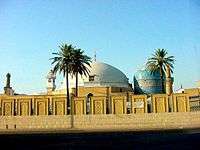Sayyid Mahmud Agha
| Hazrat Sayyid Mahmud Agha Shah Saheb | |
|---|---|
 | |
| Born |
unknown Kabul |
| Died |
October 1882 Lahore |
| Resting place | Lahore |
| Title |
Sayyid ul Sadaat(leader of the Sayyids) Khwaja-e-Khwajagane Jahan (Master of the Masters of the World) Sayyid al-Islam (Leader of the submission to Allah) Khademe Haramain wa Sharifain (Servant of Makkah and Medinah) Wasi-e-Sayyid Mir Jan (Successor of Hazrat Sayyid Mir Jan) Quduwat-ul-Salikeen (Modell of the Seekers) Qutb |
| Predecessor | Sayyid Mir Jan |
| Successor | Unknown (Uwaisiyya line) |
| Religion | Islam |
| Parent(s) | Hazrat Sayyid Mir Hasan |
Hazrat Sayyid Mahmud Agha Shah Saheb (Arabic:سید ال سادات حضرت خواجه میر سید محمود بن حسن آغا شاه صاح) was a Sufi saint from Afghanistan. He was the brother of Sayyid ul Sadaat Hazrat Sayyid Mir Jan Shah Saheb. Sayyid Mahmud Agh Shah Saheb is believed to have died in October 1882.
| Part of a series on |
| Islam |
|---|
 |
|
Related topics |
|
Ancestry
Sayyid Mahmud Agha Shah Saheb was a Sayyid (a descendant of Muhammad through his daughter Fatimah and his cousin Ali ibn Abi Talib), through his maternal and paternal lineage. Among his paternal ancestors were seven of the Twelve Imams, and his maternal ancestors included eleven of the Twelve Imams, plus Sayyid Bahauddin Naqshband, Sayyid Alauddin Atar, and Khwaja Khawand Mahmud (also known as Hazrat Eshan). After the Battle of Karbala, the Ahl al-Bayt went back to Medina.[1] From there, Musa al Kazim went to Iraq. Musa al Kazim had a son, Hamza, who went to Persia. From Persia, Sayyid Mir Hamza's descendants immigrated to Bokhara and Kabul, where Sayyid Mahmud Agh Shah Saheb was born.[2]
Biography
Family
Sayyid Mahmud Agha Shah Saheb was the third son of Sayyid Mir Hasan. His two older brothers are Sayyid ul Sadaat Sayyid Mir Fazlullah Shah Saheb and Sayyid ul Sadaat Sayyid Mir Jan Shah Saheb. Other siblings included two brothers, Sayyid Mir Azimullah and Khwaja Sayyid Mir Taqiqullah, and five sisters. Hazrat Sayyid Mahmud Agha Shah Saheb did not leave any biological children.[3]
Lineage
1 Muhammad 2 Ali and Fatima Al Zahra 3 Imam Hussain Shaheede Reza 4 Imam Ali Zayn al-Abidin 5 Imam Muhammad al Baqir 6 Imam Ja'far al-Sadiq 7 Imam Musa al Kazim 8 Abu Qasim Sayyid Mir Hamza 9 Sayyid Mir Qasim 10 Sayyid Mir Ahmad 11 Sayyid Mir Muhammad 12 Sayyid Mir Ismail Muhammad Hakim 13 Khwaja Sayyid Mir Latif 14 Khwaja Sayyid Mir Muhammad 15 Khwaja Sayyid Mir Kulal 16 Khwaja Sayyid Mir Ahmad 17 Khwaja Sayyid Mir Hashim 18 Khwaja Sayyid Mir Mustaali 19 Khwaja Sayyid Mir Dost Ali 20 Khwaja Sayyid Mir Muhammad Latif 21 Khwaja Sayyid Mir Abdullah 22 Khwaja Sayyid Mir Muhammad Shamah 23 Khwaja Sayyid Mir Latifullah 24 Khwaja Sayyid Mir Ruhollah 25 Khwaja Sayyid Mir Baitullah 26 Khwaja Sayyid Mir Nimatullah 27 Khwaja Sayyid Mir Azimullah 28 Khwaja Sayyid Mir Muhammad Hasan 29 Khwaja Sayyid Mir Fazlullah, brother of Hazrat Khwaja Sayyid Mir Jan and Hazrat Khwaja Sayyid Mahmud Agha 30 Sayyid Mir Muhammad Jan 31 Sayyida Bibi Rahima Sadat 32 Sultan Masood Dakik 33 Sayyid Mir Raphael Dakik, Sayyid Mir Matin Dakik, Sayyid Mir Hamid Dakik
Spiritual journey
Hazrat Sayyid Mahmud Agha made a journey to Lahore to see his brother. Hazrat Sayyid Mahmud Agha met his brother there and became his disciple and therefore master of the Naqshbandiya, Qadiriya, Chishtiya, Suhrawardiya, Madariya, Kubrawiya and Qalandariya way.[5]
Legacy
He is known in Sufism for his unlimited love and loyalty to his older brother Hazrat Sayyid Mir Jan, as a Sufi poet and as a Dervish, who has disconnected himself from the desire of materialism completely. It is also said that while he was very authoritarian and serious, he was also a kind and warm-hearted person. Hazrat Sayyid Mahmud Agha Shah Saheb died in Lahore and is buried on behalf of his older brother on the left of Hazrat Sayyid Mir Jans future grave, next to Hazrat Ishaan. In his mausoleum in Begampura, Lahore, his Urs, or death anniversary, is celebrated with short prayers called Zikr. It is known in Sufi metaphysics as the day when a Wali died in deep love.[6]
Spiritual rank
Sayyid Mahmud Agha Shah Saheb was a Qutb, a spiritual leader who has a divine connection with God and passes knowledge on which makes him central to, or the axis of, Sufism. [7] He was the right hand of the contemporary Ghawth, a being who has reached the stage of perfection. The contemporary Ghawth was his older brother Sayyid Mir Jan. His lineage is claimed by his followers to be the only legitimate line for the next Ghawth after him.[8][9]
Gallery

See also
- Abdul Qadir Jilani
- Ali Hujwiri
- Bahauddin Naqshband
- Moinuddin Chishti
- Hazrat Ishaan
- Ziyarat Naqshband Sahab
- Sayyid Mir Jan
References
- ↑ Imam Ali ibn al-Hussein (2001). The Complite Edition of the Treatise on Rights. Qum: Ansariyan Publications.
- ↑ Tazkare Khwanadane Hazrat Eshan(genealogy of the family of Hazrat Eshan)(by author and investigator:Muhammad Yasin Qasvari Naqshbandi company:Edara Talimat Naqshbandiyya Lahore)
- ↑ Tazkare Khwanadane Hazrat Eshan (genealogy of the family of Hazrat Eshan)(by author and investigator:Muhammad Yasin Qasvari Naqshbandi company:Edara Talimat Naqshbandiyya Lahore)
- ↑ Tazkare Khwanadane Hazrat Eshan(genealogy of the family of Hazrat Eshan)(by author and investigator:Muhammad Yasin Qasvari Naqshbandi company:Edara Talimat Naqshbandiyya Lahore)p.280,281
- ↑ Tazkare Khwanadane Hazrat Eshan(genealogy of the family of Hazrat Eshan)(by author and investigator:Muhammad Yasin Qasvari Naqshbandi company:Edara Talimat Naqshbandiyya Lahore)p.332-337
- ↑ Tazkare Khwanadane Hazrat Eshan(genealogy of the family of Hazrat Eshan)(by author and investigator:Muhammad Yasin Qasvari Naqshbandi company:Edara Talimat Naqshbandiyya Lahore)p.332-337
- ↑ Brill, E.J. (1938). Encyclopaedia of Islam. A Dictionary of the Geography, Ethnography and Biography of the Muhammadan peoples. Netherlands: Leiden. pp. 1165–1166. ISBN 90-04-09796-1.
- ↑ Sufi Sheikhs of Pakistan and Afghanistan
- ↑ Tazkare Khwanadane Hazrat Eshan(genealogy of the family of Hazrat Eshan)(by author and investigator:Muhammad Yasin Qasvari Naqshbandi company:Edara Talimat Naqshbandiyya Lahore)

